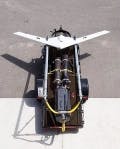Flight tests of UAV sense-and-avoid technology is part of Barron Associates, AeroMech research project
SAN LUIS OBISPO, Calif., 16 Sept. 2010.Machine intelligence experts on a team of Barron Associates Inc. in Charlottesville, Va., and AeroMech Engineering Inc. in San Luis Obispo, Calif., are preparing for flight tests to determine the effectiveness of recently developed sense-and-avoid technology that helps prevent formations of unmanned aerial vehicles (UAVs) from accidentally colliding with each other and with manned aircraft flying in the same area.
The Barron Associates and AeroMech team won a $2.4 million contract last April from the U.S. Air Force Research Laboratory (AFRL) at Wright-Patterson Air Force Base, Ohio, for the Multi-Vehicle Unmanned Aircraft Systems Sense And Avoid (MUSAA) program to develop autonomous sense-and-avoid (SAA) collision-avoidance technology to prevent UAVs from hitting or interfering with other manned and unmanned aircraft.
When the contract was awarded, AeroMech had not been announced as a member of the Barron Associates team. Barron Associates specializes in intelligent and adaptive technologies to measure, model, predict, and control complex systems to improve performance, safety, and efficiency. The firm develops technology to give machines the ability to learn and adapt to new and unforeseen conditions. AeroMech, meanwhile, designs UAVs ranging from 4-pound battery powered aircraft to 150-pound jet powered models, including the Fury UAV for specialized defense missions.
"The key to our approach is testing, evaluating, and demonstrating the developed technologies with actual UAS formations -- not just simulations," says Jay McConville, president and chief executive officer of AeroMech.
Barron Associates and AeroMech will capitalize on current AFRL Sense and avoid development for the MUSAA program will develop and flight test technologies that address the risk of unintentional conflicts or collisions between manned and unmanned aircraft, and ultimately may help UAVs and commercial aircraft operate safely in congested terminal control areas over and around major cities.
The program will consist of integrating multi-vehicle coordination and formation flight algorithms with current sense-and-detect technologies from Barron Associates into the AeroMech's Flight Control Augmentation System (FCAS) autopilot. AeroMech conduct flight tests to demonstrate coordinated control of a multi-UAV system with the developed sense and avoid technologies. Flight tests will focus on formation flight scenarios.
For more information contact Barron Associates online at www.barron-associates.com, AeroMech Engineering at www.aeromechengineering.com, or the Air Force Research Laboratory at www.wpafb.af.mil/AFRL.

